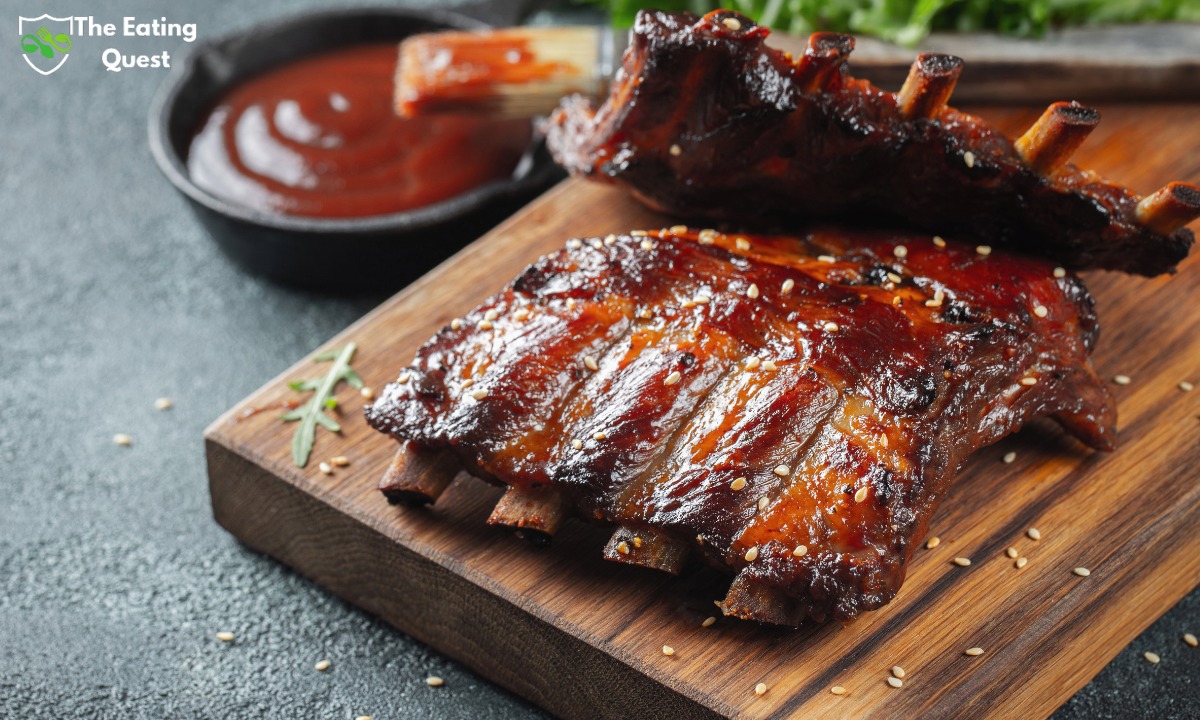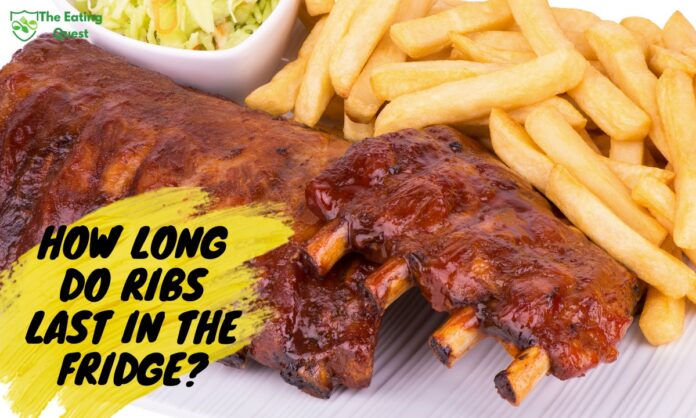When it comes to ribs, they are a favorite among many people. Whether you prefer beef or pork, ribs are a delicious and flavorful dish that can be enjoyed in various ways. But how long do ribs last in the fridge? This question is essential to consider if you want to ensure the safety and quality of your food.
Understanding how to store ribs in the fridge properly is crucial to keeping them fresh for as long as possible. The USDA recommends that cooked ribs be consumed within three to four days, while raw ribs should be cooked or frozen within 3 to 5 days. However, the exact amount of time that ribs last in the fridge can vary depending on several factors, such as the type of ribs, how they are stored, and the temperature of your fridge.
Regarding food safety, it’s important to be aware of the risks of consuming spoiled or expired food. Spoiled ribs can cause food poisoning, which can lead to a range of symptoms, such as nausea, vomiting, and diarrhea. In order to avoid these risks, it’s important to properly store and handle your ribs to ensure their freshness and quality.
How Long Do Ribs Last in the Fridge?
If you’re a fan of ribs, you know that there are different types of ribs, including pork ribs, beef ribs, baby back ribs, and spare ribs. Ribs can be smoked, grilled, marinated, and seasoned with rubs.
When it comes to storing ribs, it’s essential to understand that the shelf life of ribs depends on whether they are raw or cooked. Raw ribs can last up to 4 days in the fridge, while cooked ribs can last 3-5 days.
One thing to keep in mind is that leftover ribs should be stored properly to avoid spoilage. Make sure to wrap them tightly in aluminum foil or plastic wrap and store them in an airtight container.
If you’re planning to marinate your ribs, it’s best to do so in the fridge. Marinated ribs can last up to 2 days in the fridge before cooking.
When grilling or smoking ribs, it’s important to cook them thoroughly to ensure they are safe to eat. The internal temperature of cooked ribs should reach 145°F for pork and 160°F for beef.
In summary, understanding the different types of ribs and how to store and cook them properly can help you enjoy delicious ribs while avoiding any potential health risks.
Ribs and Food Safety
When it comes to ribs, food safety is crucial to avoid foodborne illness. Bacteria can overgrow in the danger zone between 40 and 140 degrees Fahrenheit. Therefore, keeping your ribs stored below 40 degrees Fahrenheit is essential to prevent bacterial growth.
The USDA recommends eating or properly storing cooked ribs within four days if your fridge is under 40°F. Cooked pork ribs can be stored in the refrigerator for three to four days. However, it’s important to note that raw pork ribs tend to only stay good for 3-5 days once cooked.
To avoid cross-contamination, storing your ribs in airtight containers or wrapping them tightly in aluminum foil or plastic wrap is essential. Additionally, it’s important to avoid keeping your ribs at room temperature for more than two hours. If your ribs have been left out for longer than two hours, it’s best to discard them.
To tell if your ribs are bad, look for signs of spoilage, such as a sour smell, slimy texture, or discoloration. If you need clarification on whether your ribs are safe to eat, it’s best to err on caution and discard them.
Food poisoning can be a severe issue, so handling your ribs with care and following proper food safety guidelines is essential. By storing your ribs properly and being mindful of the danger zone, you can enjoy delicious and safe ribs.
Storing Ribs in the Fridge
When it comes to storing ribs in the fridge, there are a few things you need to keep in mind to ensure they stay fresh and safe to eat. Whether you have raw or cooked ribs, storing them properly is essential to maximize their shelf life. Here are some tips to help you store your ribs in the fridge:
- Use an airtight container: When storing ribs in the fridge, keeping them in an airtight container is essential to prevent air from getting in and causing them to spoil faster. You can also use plastic wrap or aluminum foil to wrap them tightly.
- Label and date your ribs: To keep track of how long your ribs have been in the fridge, it’s a good idea to label and date them. This will help you avoid eating ribs that have been in the refrigerator for too long and may no longer be safe to eat.
- Store at the right temperature: To ensure your ribs stay fresh, store them in the fridge at a temperature of 40°F or below. This will help slow down the growth of bacteria that can cause foodborne illness.
- Know the shelf life: Raw ribs typically last in the fridge for about 3-5 days, while cooked ribs can last up to 4 days. However, it’s essential to remember that these are just general guidelines, and the actual shelf life can vary depending on factors like how the ribs were cooked and stored.
- Refrigerate your ribs promptly: To maximize the shelf life of your ribs, it’s important to refrigerate them promptly after they’ve been cooked or purchased. Leaving them out at room temperature for too long can increase the risk of bacterial growth and spoilage.
By following these tips, you can help ensure that your ribs stay fresh and safe to eat for as long as possible. Remember always to use your best judgment and discard any ribs that look or smell off, even if they have yet to reach the end of their shelf life.
Determining Freshness and Quality of Ribs
When determining the freshness and quality of ribs, you should keep a few things in mind. Here are some tips to help you determine whether your ribs are still good to eat:
Freshness
One of the easiest ways to determine the freshness of your ribs is to look at the sell-by or use-by date. If the date has passed, it’s best to discard the ribs. However, if the date is still valid, there are a few other things you can look for.
Color
Fresh ribs should be a pinkish-red color. If the ribs have turned grayish-brown, they may be past their prime and should be discarded.
Smell
Fresh ribs should have a slightly sweet smell. If the ribs have a sour or unpleasant odor, they may be spoiled and should be discarded.
Texture
Fresh ribs should be firm to the touch and not slimy. If the ribs feel slimy or have a sticky texture, they may be spoiled and should be discarded.
Mold
If you see any mold on the ribs, it’s best to discard them immediately. Mold can be a sign of spoilage and can be harmful if ingested.
Odor
If you notice a strong odor from the ribs, it may be a sign that they are spoiled. Trust your nose and discard ribs with a strong, unpleasant odor.
Quality
In addition to freshness, you also want to consider the quality of the ribs. Look for tender and succulent ribs with a good amount of meat on the bone. Avoid tough or dry ribs, as they may be less flavorful.
By following these tips, you can ensure that your ribs are fresh and of good quality. Remember, when in doubt, it’s always better to err on caution and discard any ribs you think may spoil.

Freezing and Defrosting Ribs
Freezing them is a great option if you want to keep your ribs longer. When frozen correctly, ribs can last up to four months in the freezer without losing quality. Here are some tips on how to freeze and defrost your ribs:
Freezing Ribs
- Cool the Ribs: Let your ribs cool to room temperature before freezing them. This will prevent the formation of ice crystals and freezer burn.
- Wrap the Ribs: Wrap your ribs tightly in plastic wrap or aluminum foil. You can also use a freezer-safe bag or container. Make sure to remove as much air as possible to prevent freezer burn.
- Label and Date: Label your ribs with the freezing date and type of ribs. This will help you track how long they have been in the freezer and what they are.
- Place in Freezer: Place your wrapped ribs in the freezer. Make sure to put them in a spot where they won’t get crushed or damaged.
Defrosting Ribs
- Plan Ahead: Defrosting ribs takes time, so plan. You can defrost them in the fridge, cold water, or microwave.
- Fridge Defrosting: This is the safest way to defrost your ribs. Place your frozen ribs in the fridge and let them defrost for 24-48 hours.
- Cold Water Defrosting: If you’re in a hurry, you can defrost your ribs in cold water. Place your frozen ribs in a sealed plastic bag and submerge them in cold water. Change the water every 30 minutes until they are defrosted.
- Microwave Defrosting: You can also defrost your ribs in the microwave. Use the defrost setting and follow the manufacturer’s instructions.
- Cook Immediately: Once your ribs are defrosted, cook them immediately. Do not refreeze them.
Following these tips, you can safely freeze and defrost your ribs and enjoy them for months.
Reheating and Cooking Ribs
When it comes to reheating ribs, you can use a few methods to get them just right. The best way to reheat ribs is in the oven, but you can also use a microwave or grill if you’re short on time.
To reheat ribs in the oven:
- Preheat it to 250°F.
- Coat the ribs with your favorite barbecue sauce or other spices.
- Wrap the ribs tightly in foil and place them in a baking dish.
- Bake for about 20-30 minutes or until the internal temperature reaches 165°F.
If you’re in a hurry, you can reheat ribs in the microwave. Place the ribs on a microwave-safe plate and cover them with a damp paper towel. Microwave on high for 2-3 minutes or until heated through.
When it comes to cooking ribs, there are many methods you can use, including smoking, grilling, and baking. The most popular way is to barbecue them. You’ll need a good barbecue sauce and some spices to barbecue ribs.
To prepare the ribs:
- Remove the membrane from the back of the ribs and season them with your favorite spices.
- Preheat your grill or smoker to 225°F and place the ribs on the grill.
- Cook the ribs for about 4-5 hours or until the internal temperature reaches 165°F.
If you’re cooking ribs in the oven, preheat it to 300°F. Place the ribs in a baking dish and cover them with barbecue sauce. Bake for about 2-3 hours or until the internal temperature reaches 165°F.
When handling ribs, it’s important to remember to keep them refrigerated until you’re ready to cook or reheat them. Ribs can last in the refrigerator for 3-6 days if stored properly. Always cook the ribs to the proper internal temperature to avoid foodborne illness.
Packaging and Labeling
Proper packaging and labeling are essential to ensure their freshness and safety when it comes to storing ribs in the fridge. Here are some tips to help you keep your ribs in top condition:
- Foil or Plastic Wrap: If you plan to store your cooked ribs in the fridge for a few days, you can wrap them tightly in aluminum foil or plastic wrap. This will help prevent air from getting in and keep the ribs moist. However, use airtight containers or resealable bags to store them for extended periods.
- Cryovac or Vacuum Seal: If you buy ribs from a retailer, they may come in cryovac packaging or vacuum-sealed bags. These packaging methods can help extend the shelf life of the ribs by removing air and creating a tight seal. However, once you open the packaging, transfer the ribs to airtight containers or resealable bags.
- Sell-By Date: Most retailers will put a sell-by or best-by date on their rib products. While this date can be a helpful guideline, it shouldn’t be the sole determining factor in your decision to use or discard the ribs. Always use your senses to check for signs of spoilage, such as an off odor or slimy texture, before consuming the ribs.
- Proper Labeling: When storing ribs in the fridge, it’s essential to label them with the date you cooked or purchased them. This will help you track how long they’ve been in the fridge and avoid consuming them past their prime.
By following these packaging and labeling tips, you can help ensure your ribs stay fresh and safe for as long as possible.
Spoilage and Deterioration
Regarding ribs, it’s essential to be aware of the signs of spoilage and deterioration. Spoilage is when the food is no longer safe to eat due to bacterial or mold growth. In contrast, deterioration refers to the point where the quality of the food has degraded to the point where it is no longer desirable to eat.
An off smell is one of the most noticeable signs that your ribs have gone bad. If your ribs smell sour or rancid, it’s a good indication that bacterial growth has occurred. Additionally, if the texture of your ribs is slimy or sticky, it’s a sign that mold growth has occurred, and the ribs should be discarded immediately.
To prevent spoilage and deterioration, storing your ribs properly is essential. If your ribs are raw, they should be stored in the refrigerator for no more than 4 days. If your ribs are cooked, they can last up to 5 days in the fridge. However, it’s important to keep your refrigerator at or below 40°F to prevent bacterial growth.
It’s also important to properly package your ribs to prevent exposure to air and moisture, which can accelerate spoilage and deterioration. If you’re storing your ribs in the refrigerator, wrap them tightly in plastic or aluminum foil. Use freezer-safe bags or containers if you’re keeping them in the freezer.
In summary, it’s important to know the signs of spoilage and deterioration when storing ribs. Proper storage and packaging can help prevent bacterial and mold growth and ensure your ribs stay fresh for as long as possible.
Portioning and Serving
When it comes to portioning and serving ribs, remember a few things to ensure you get the most out of your meal. Here are some tips to help you with that:
- Portion sizes: A typical serving size for ribs is around 1/2 to 1 pound per person, depending on appetite. Remember that the bones will add weight, so you may want to purchase more than you need.
- Leftovers: If you have leftover ribs, store them in an airtight container in the fridge for up to 4-5 days. To reheat, place them in a baking dish with a bit of water, cover with foil, and bake at 350°F until heated.
- Flavor and taste: Ribs are often marinated or brushed with sauce before cooking, adding flavor. However, if you prefer a natural taste, you can skip the marinade or sauce and season with your favorite spices.
- Sauce and marinade: If you decide to use a sauce or marinade, remember that they can mask the flavor of the meat. Consider serving the sauce on the side so guests can add as much or as little as they like.
- Presentation: Ribs can be messy, so consider serving them with wet wipes or napkins. You can also garnish with fresh herbs or lemon wedges to add a pop of color and freshness to your plate.
Overall, portioning and serving ribs is all about personal preference. Whether you like them saucy or dry, spicy or mild, there’s no right or wrong way to enjoy this classic barbecue dish.
Frequently Asked Questions
How long are cooked baby back ribs good for in the fridge?
Cooked baby back ribs can last about three to four days in the fridge. Store them properly in an airtight container or wrap them tightly in foil to maintain their quality and flavor.
How long do cooked beef ribs last in the fridge?
Cooked beef ribs, like baby back ribs, can last in the fridge for about three to four days. Store them properly in an airtight container or wrap them tightly in foil to prevent them from drying out.
How long do raw short ribs last in the fridge?
Raw short ribs can last in the fridge for up to three to five days, depending on how fresh they were when you bought them. Store them in an airtight container or wrap them tightly in plastic to keep them fresh.
Can I eat cooked ribs after 5 days?
Eating cooked ribs after five days is not recommended, as they may have gone bad and could cause food poisoning. Always follow food safety guidelines and discard any food in the fridge for too long.
How long are ribs good in the fridge after thawing?
Thawed ribs, like freshly cooked ribs, can last in the fridge for about three to four days. Store them properly in an airtight container or wrap them tightly in foil to maintain their quality and flavor.
How long can ribs marinate in the fridge?
Ribs can be marinated in the fridge for up to 24 hours. Make sure to keep them in an airtight container or ziplock bag to prevent any leaks or spills. Marinating for too long can cause the meat to become mushy or over-flavored, so follow the recipe’s instructions carefully.
Also Read:
How Long Do Baked Beans Last in the Fridge?
How to Store Cooked Salmon in the Fridge
















